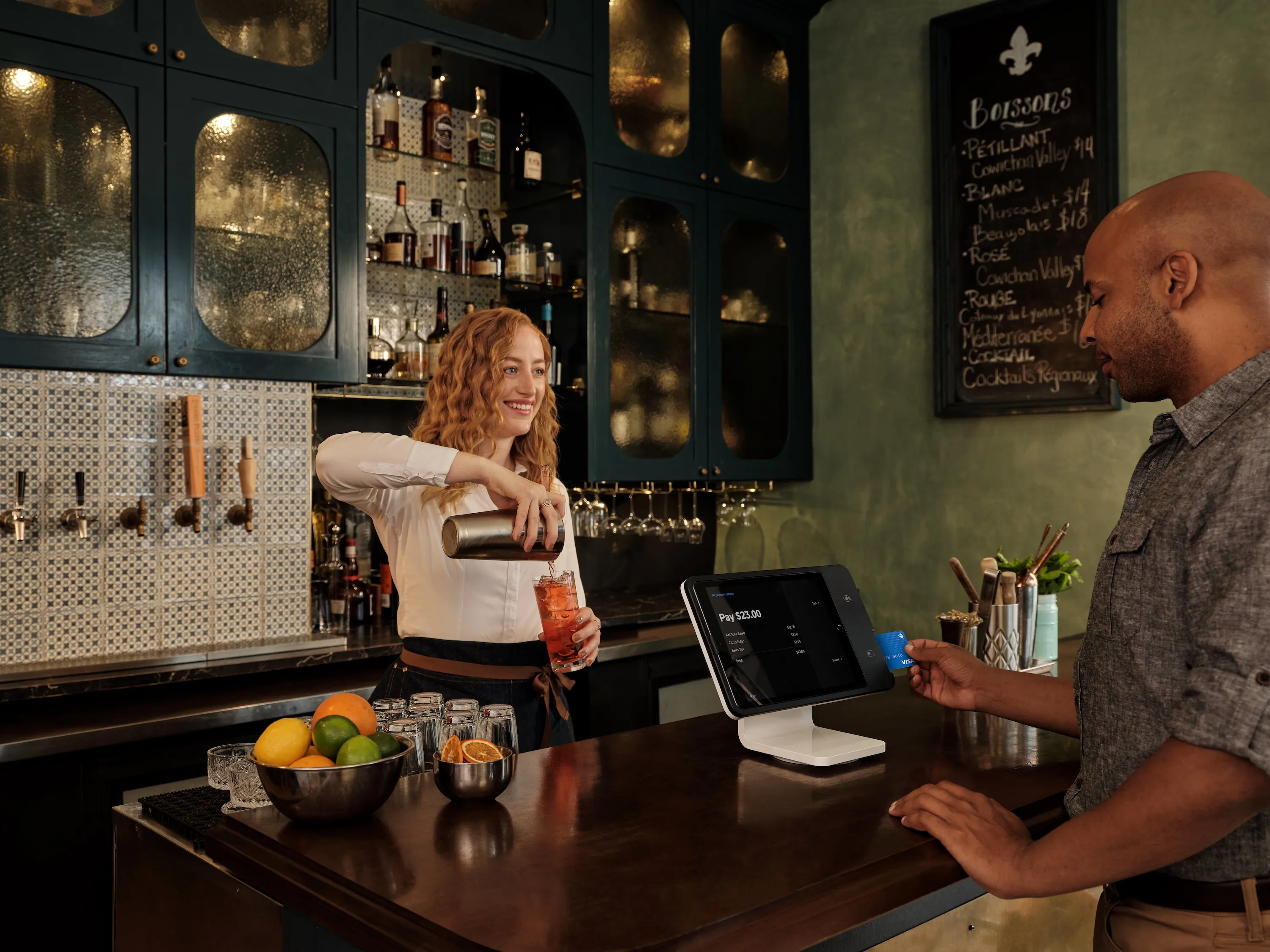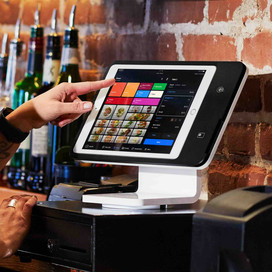Table of contents
Opening your own restaurant is an exciting journey filled with creativity, passion, and the chance to bring people together through great food. While opening a restaurant business takes hard work and planning, the rewards — crafting unforgettable dining experiences, building a loyal customer base, and turning your vision into reality — are well worth it.
Whether you’re a seasoned chef or a first-time entrepreneur, this step-by-step guide on how to open a restaurant will help you navigate the essentials, from concept development to opening night.
1. Define your restaurant concept
Defining your restaurant concept is the foundation of your entire venture: A well-defined concept shapes your brand, menu, and customer experience and also ensures consistency in everything from pricing to marketing while helping to set you apart in a competitive industry.
Here’s how to get started:
- Select a cuisine type that aligns with your passion and local demand, whether it’s authentic Neapolitan pizza, modern vegan fare, or upscale fusion dishes.
- Choose a service style, whether that’s fast-casual, fine dining, food truck, or family-style, that fits your vision and audience.
- Nail your restaurant ambiance, be it rustic and cozy or sleek and modern. Keep in mind your restaurant’s setup and atmosphere should reflect your theme and appeal to your target market, whether that’s young professionals, families, or foodies.
- Pinpoint what makes your restaurant unique. Maybe it’s a signature dish, a rare cuisine in your area, or an immersive dining experience.
- Research local gaps in the market, and align your concept with both demand and your culinary strengths.
- Make sure your restaurant branding reflects your concept, so that your restaurant name, logo, and voice establish a cohesive story that resonates with diners. A clear, compelling concept is one of the key features of starting a restaurant, as it not only guides décor, staffing, and operations but also helps attract the right customers from day one.
2. Create a business plan for your restaurant
A well-crafted restaurant business plan is your restaurant’s roadmap to success. It will guide your decisions, help you attract investors and secure funding, and allow you to transform your vision into a structured strategy, proving your concept’s viability to lenders and partners.
Here are some key components you might want to include in your restaurant business plan:
- An executive summary to provide a brief overview of your restaurant’s vision, mission, and unique selling points while also highlighting key financial projections and growth potential.
- A company overview that explains your business’s legal structure (LLC, corporation, sole proprietorship, etc.), rationale for its location, and ownership details, including your restaurant’s founders, investors, and partners.
- Your restaurant concept and menu, which will describe the type of cuisine you will serve along with your service style, possibly some sample dishes and pricing strategy, and an explanation of what makes your restaurant stand out from competitors.
- A market analysis that describes your target demographic, local demand, and an assessment of your competitors.
- Your marketing plan, which will include your restaurant name and logo as well as your marketing and promotional strategies.
- An operations plan that describes your staffing needs, suppliers you will use, how you’ll manage your inventory, and what you envision for the restaurant’s daily workflow.
- Financial projections, including how much it will cost to open your restaurant (lease, equipment, licenses, and marketing), projected revenue and profit margins, and a break-even analysis and funding requirements.
- An industry overview that shows you understand current restaurant trends and how to open a restaurant business even in the face of potential economic factors that could impact your costs and revenue.
- A SWOT analysis that describes your restaurant business’s strengths, weaknesses, opportunities, and threats.
- Information on your ownership and management team, including bios or resumes of key team members, including managers, chefs, and investors.
- Milestones and timelines you need to meet, including obtaining permits and licenses, hiring staff, soft and/or grand openings, and deadlines for each stage of development.
- Supporting documents that help make the case for financing, such as a sample menu, floor plans, copies of permits and licenses, and mockups of marketing materials.
3. Plan your restaurant funding strategy
Opening a restaurant requires significant upfront capital for space, equipment, permits, staffing, and marketing. A solid funding strategy is key to getting started and staying afloat in the early months. Assess how much it will cost to open your restaurant and operate it. Be sure to calculate your break-even point, and create a financial analysis as well to get a better understanding of your predicted cash flow.
There are a number of potential funding options to consider for starting a restaurant:
- Small Business Administration loans
- Square Loans
- Credit union loans
- Traditional bank loans
- Business line of credit
- Private investors
- Crowdfunding
4. Obtain the licenses and permits needed to open a restaurant
Before serving your first customer, securing the right licenses and permits is crucial to opening your restaurant legally and avoiding costly fines or delays. Requirements vary by location, but common essentials include the following:
- Business license
- Employer Identification Number (EIN) for taxes and payroll
- Food service license from your local health department
- Liquor license if you plan to serve alcohol
- Signage permits for exterior displays
- Occupancy permits to ensure your space meets safety codes.
Since approvals can take weeks or even months, start early and consider consulting local authorities (your city or county website is a great place to start) for a complete checklist tailored to your restaurant concept and location. Proper licensing provides the foundation for a smooth and compliant grand opening.
5. Register your business
One of the things you’ll need to open a restaurant is a business registration. Make sure to register your business with the IRS to receive your Employer Identification Number, so you can file taxes. You might consider trademarking your restaurant’s name, too (to stop people from copying you and capitalizing on your restaurant’s success).
6. Choose the right location for your restaurant
Choosing the right location is one of the most critical decisions you’ll make for your restaurant. Location is often the largest determinant of success or failure when you start a restaurant. The ideal spot should align with your concept, draw in your target audience, and stay within budget. For example, a high-visibility area with heavy foot traffic may cost more but can drive steady customers, while a hidden gem could work for opening a small restaurant if you have a strong marketing plan.
Consider the surrounding businesses, local demographics, and competition to ensure your restaurant setup fits the neighborhood’s vibe and demand. Don’t just settle for affordability: Prioritize long-term viability because even the best food can struggle in the wrong location.
Here are some key factors to consider:
- Foot traffic and visibility: Is your restaurant easy to find with good signage potential?
- Accessibility and parking: Is your restaurant location convenient for drivers, pedestrians, and public transit?
- Local competition: Are there too many similar restaurants in the area, or have you identified an untapped opportunity?
- Target market: Does the neighborhood match your ideal customer’s income and dining habits?
- Cost and lease terms: Can you afford rent, utilities, and build-out expenses? Are lease terms flexible?
- Future growth potential: Is the area developing or at risk of decline?
- Delivery and takeout viability: Is the location convenient for delivery drivers if you plan to offer takeout options?
7. Create a menu
Your menu is the centerpiece of your restaurant and should reflect your concept and brand. But it’s also a marketing tool that can help convince new customers to try your restaurant. Here are some tips for building your restaurant menu:
- Concept alignment: Ensure your dishes reflect your restaurant’s theme, cuisine, and brand identity, and tailor offerings to your target audience’s preferences.
- Balance and variety: Include diverse options (vegetarian, vegan, and gluten-free, for example) to cater to different diets, or offer a mix of flavors, textures, and portion sizes.
- Pricing strategy: Research competitor pricing and perceived value, and make sure to avoid under or overpricing. Calculate your food costs, and aim for a 25-35% food cost ratio to maintain profitability.
- Ingredient sourcing: Partner with reliable suppliers for consistent, high-quality ingredients, and consider seasonal availability and local sourcing for freshness and marketing appeal.
- Menu design: Organize logically (drinks, starters, mains, desserts) for easy navigation, and use concise, enticing descriptions. Limit choices to reduce decision fatigue and kitchen complexity. If you have high-profit items, strategically place them in prime spots on the menu, highlighting them with bold fonts or icons.
- Operational feasibility: Make sure your dishes align with kitchen size, equipment, and staff skill level.
- Testing and refinement: Conduct staff tastings, gather customer feedback, and set yourself up to adapt to seasonal availability as well as ingredient costs. Identify underperforming menu items and look for opportunities for specials or menu rotations.
Remember that a great menu evolves with your customers and market!
8. Design an efficient restaurant layout
A smart restaurant layout balances efficiency, safety, and comfort. The front-of-house needs a logical flow from entry to dining with well-spaced seating. The back-of-house requires a streamlined kitchen workflow with designated prep, cooking, and storage zones. Your key priorities should include:
- Smooth staff movement
- Maximum seating without crowding
- Strict compliance with health, safety, and accessibility codes
Before opening your restaurant, test layouts with staff walkthroughs before finalizing. Small tweaks can prevent big operational headaches later.
9. Order restaurant equipment
When ordering restaurant equipment, start by selecting items that directly support your menu and cooking methods. Don’t waste money on unnecessary appliances. Invest in reliable, energy-efficient models to reduce long-term costs, even if the upfront price is higher. Balance your budget by mixing new and used equipment. For example, you can buy critical items like ovens and refrigeration new for warranties and efficiency, while considering gently used prep tables or shelving to save cash.
Here are some tips for planning the purchase of equipment for your restaurant setup:
- Have a menu-first approach. For example, you’ll want a grill for burgers and woks for Asian cuisine.
- Buy Energy Star-rated appliances to lower utility bills.
- Take advantage of used bargains. Look for auction deals or restaurant closures.
- Pay the extra for service contracts for high-use equipment like HVAC and dishwashers.
- Rent or lease expensive specialty equipment (like pizza ovens) to test demand before buying.
- Purchase reliable and fast restaurant point-of-sale (POS) equipment. You want your customers to have an efficient and pleasant dining experience from start to finish!
10. Hire the right staff
Your staff will ultimately make or break your restaurant, so do your due diligence before you hire. Make a list of how much support you need to run your front and back of house efficiently. Once hired, make sure your employees understand what’s expected of them and that you provide an environment that will encourage retention:
- Define roles clearly (e.g., management team, kitchen staff, front-of-house staff, bar staff, etc.).
- Thoroughly train staff on service standards and safety protocols.
- Foster a positive working environment.
You’ll also need to determine if you want to process payroll yourself or use payroll software. Just keep in mind that restaurant payroll can be complex, especially with varying state, federal, and local laws and regulations around wages and tips. Make sure you understand the rules for your state and locality.
11. Promote your restaurant launch
You’ve completed all the grunt work of your restaurant setup and are ready for opening! Make your restaurant launch unforgettable with smart pre- and post-opening hype geared toward your target audience. Here are some ideas:
- Tease your concept through social media sneak peeks and local influencer collaborations.
- Secure visibility on Google and Yelp.
- Fuel word-of-mouth with soft openings and launch promotions.
- Partner with neighboring businesses for cross-promotion.
- Embed yourself in the community through sponsorships or charity tie-ins.
Be sure to track which marketing channels bring in the most customers, and then double down on what works.

How to open a restaurant FAQs
What kind of restaurant should I open?
There are a wide array of restaurant types, and determining what suits your business interests will depend on your desired cuisine, audience, location, and startup costs. Here are the key restaurant segments to consider:
- Food truck businesses provide an excellent opportunity for aspiring restaurateurs to break into the industry because they tend to be more affordable than a brick-and-mortar location.
- Pop-up restaurants are another great way to test out a menu and gauge customer interest in a temporary setting.
- Quick service restaurants (QSRs), specialize in quick preparation (many menu items can be made in less than two minutes) and counter service, with self-seating and minimal frills.
- Fast-casual establishments are a slight step up in complexity from quick service restaurants. They’re still built on a counter service or kiosk ordering model and open dining room seating. However, their menus are more complex and customizable, with food that takes slightly longer to prepare and slightly higher prices.
- Casual dining offers a full-service restaurant experience for customers at an affordable price.
- Fine dining restaurants provide customers with an elegant and upscale dining experience with higher price points, top-quality food, and the best service the industry can provide.
What do I need to know about restaurant safety and food handling?
Restaurant safety and food handling protocols are top priorities, and the restaurant industry is heavily regulated at city, state, and federal levels. Local health department regulations vary depending on where you decide to open a restaurant. If you are considering multiple locations, each restaurant could have a different set of compliance obligations. Be sure to check out your restaurant state guidelines.
A restaurant may be subject to several inspections to verify its safety and operational compliance, including an initial inspection and subsequent visits throughout the year, so you’ll want to develop best practices for food safety and restaurant sanitation.
How much does it cost to open a restaurant?
Restaurant startup costs are dependent on various factors, including:
- Size of the restaurant
- Type of restaurant (see above)
- Number of staff
- Restaurant real estate
While the cost of starting a restaurant varies significantly, most new establishments will spend well into the six figures to open their doors. And incorrect forecasts and budgeting are a major reason why restaurants fail. However, there are plenty of financing options for restaurant owners to help get started.
How do I take payments from customers?
Taking payments from customers is simpler than ever before. First, you need to choose a payment processor. A payment processor handles credit, debit, and other transactions for your business. You want to look for a payment processor that accepts all major credit cards, has one consistent rate (with no hidden fees), and has quick deposit times.
An intuitive point-of-sale system lets you get started taking payments quickly, and it can also grow with your restaurant (and help it grow). An integrated restaurant point of sale not only lets you accept all types of payments — including magstripe, EMV chip, and NFC (mobile payments) — but can also help you run your entire restaurant more efficiently.
Visit our Square for Restaurants Demo page to see how we make taking payments and running a restaurant easier.
What restaurant trends should I be watching?
Restaurant owners are responsible for staying ahead of trends in the restaurant industry, but that doesn’t just entail the latest food fads. Here are a few emerging restaurant trends to note:
- Immediate customer feedback is one of several customer engagement features that allow restaurant owners to get a better understanding of what their customers want sooner rather than later.
- Acceptance of mobile wallets like Apple Pay have become increasingly popular and are shaping the future of payments. Some of the key benefits of accepting mobile wallets include increased security, speed, and convenience.
- Delivery services to reach a wider customer base.
- Self-serve ordering for tableside contact-free dining.
Tips from 3 restaurateurs on how to start a restaurant
We’ve tackled how to open a restaurant. Now there’s the million-dollar question every aspiring restaurant owner asks: Will my restaurant be successful? Here are three tips from experienced owners that you can use when starting out:
- Stay resilient.
Tod Wilson, the owner of the prosperous Mr. Tod’s Pie Factory in New Jersey, stresses the need for resiliency: “Keep fighting. Every time I find myself in a tough position, I think about that. You have to just get up after you get knocked down. Whether it’s a product recall, not getting an order in, or losing a new hire, you have to be able to bounce back.” - Make a great first impression.
Jeff Heck, the owner of Atlanta’s Monday Night Brewing emphasizes the first-time experience for a customer. You essentially have one time to get it right and make an impression on a first-time customer. If guests have one bad experience, “odds are they’ll never try it again.” - Stay true to your brand.
Young Han is the head of community outreach at Philz Coffee and believes you should “never forget why you started. Always circle back to that and stay true to your core.”













